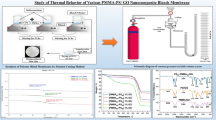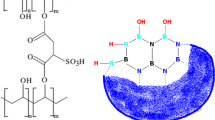Abstract
We prepared poly(vinyl alcohol) (PVA)/SiO2 and PVA/SiO2/glutaraldehyde (GA) nanocomposite membranes in a single step using the solution casting method. The structure, morphology, and properties of these nanocomposite membranes were characterized by Raman spectroscopy, atomic force microscopy, small- and wide-angle X-ray scattering, thermogravimetric analysis, differential scanning calorimetry, and dynamic mechanical analysis (DMA). The influence of silica and GA loading on the meso-scale characteristics of the composite membranes was investigated. The results showed that silica deposited in the form of small nanoparticles (~1 nm) in the PVA/SiO2 membranes, while bigger submicron particles (>25 nm) were formed in the PVA/SiO2/GA membranes. The water uptake of the PVA/SiO2 membranes increased with temperature, but the PVA/SiO2/GA membranes were completely dissolved above 50 °C. We can therefore conclude that the addition of GA deteriorated the properties of PVA/SiO2 membranes. The thermal stability of the PVA/SiO2 membranes increased with the increasing silica loading with a maximum char yield of 46 % for PVA/SiO2/4T. Even DMA profiles indicated a promising increase in E R (rubbery modulus) from 6 MPa (PVA membrane) to 1015 MPa (PVA/SiO2/4T) at 250 °C, showing high mechanical strength of these membranes.















Similar content being viewed by others
References
Lin W, Zhu T, Li Q, Yi S, Li Y (2012) Study of pervaporation for dehydration of caprolactam through PVA/nano silica composite membranes. Desalination 285:39–45
Ceia TF, Silva AG, Ribeiro CS, Pinto JV, Casimiro MH, Ramos AM, Vital J (2014) PVA composite catalytic membranes for hyacinth flavour synthesis in a pervaporation membrane reactor. Catal Today 236:98–107
Yang D, Li Y, Nie J (2007) Preparation of gelatin/PVA nanofibers and their potential application in controlled release of drugs. Carbohydr Polym 69:538–543
Yadav R, Kandasubramanian B (2013) Egg albumin PVA hybrid membranes for antibacterial application. Mater Lett 110:130–133
Wu Y, Wu C, Li Y, Xu T, Fu Y (2010) PVA–silica anion-exchange hybrid membranes prepared through a copolymer crosslinking agent. J Membr Sci 350:322–332
Chen H, Yuan D, Li Y, Dong M, Chai Z, Kong J, Fu G (2013) Silica nanoparticle supported molecularly imprinted polymer layers with varied degrees of crosslinking for lysozyme recognition. Anal Chim Acta 779:82–89
Liu Z, Dong Y, Men H, Jiang M, Tong J, Zhou J (2012) Post-crosslinking modification of thermoplastic starch/PVA blend films by using sodium hexametaphosphate. Carbohydr Polym 89:473–477
Santos C, Silva CJ, Büttel Z, Guimarăes R, Pereira SB, Tamagnini P, Zille A (2014) Preparation and characterization of polysaccharides/PVA blend nanofibrous membranes by electrospinning method. Carbohydr Polym 99:584–592
Li G, Zhao Y, Lv M, Shi Y, Cao D (2013) Super hydrophilic poly(ethylene terephthalate) (PET)/poly(vinylalcohol) (PVA) composite fibrous mats with improved mechanical properties prepared via electrospinning process. Colloids Surf A 436:417–424
Na H, Chen P, Wong SC, Hague S, Li Q (2012) Fabrication of PVDF/PVA microtubules by coaxial electrospinning. Polymer 53:2736–2743
Zhu M, Qian J, Zhao Q, An Q, Li J (2010) Preparation method and pervaporation performance of polylectrolyte complex/PVA blend membranes for dehydration of isopropanol. J Membr Sci 361:182–190
Irani M, Keshtkar AR, Moosavian MA (2012) Removal of cadmium from aqueous solution using mesoporous PVA/TEOS/APTES composite nanofiber prepared by sol–gel/electrospinning. Chem Eng J 200–202:192–201
Zeng C, He Y, Li C, Xu Y (2013) Synthesis of nanocrystalline LaMn0.5Fe0.5O3 powders via PVA sol–gel route. Ceram Int 39:5765–5769
Holloway JL, Lowman AM, Landingham MRV, Palmese GR (2013) Chemical grafting for improved interfacial shear strength in UHMWPE/PVA-hydrogel fiber-based composites used as soft fibrous tissue replacements. Compos Sci Technol 85:118–125
Ajji Z, Ali AM (2010) Separation of copper ions from iron ions using PVA-g-(acrylic acid/N-vinylimidazole) membranes prepared by radiation-induced grafting. J Hazard Mater 173:71–74
Morgado PI, Lisboa PF, Ribeiro MP, Miguel SP, Simões PC, Correia IJ, Ricardo AA (2014) Poly(vinylalcohol)/chitosan asymmetrical membranes: highly controlled morphology toward the ideal wound dressing. J Membr Sci 469:262–271
Li N, Xiao C, An S, Hu X (2010) Preparation and properties of PVDF/PVA hollow fiber membranes. Desalination 250:530–537
M’barki O, Hanafia A, Bouyer D, Faur C, Sescousse R, Delabre U, Blot C, Guenoun P, Deratani A, Quemener D, Pochat-Bohatier C (2014) Greener method to prepare porous polymer membranes by combining thermally induced phase separation and crosslinking of poly(vinyl alcohol) in water. J Membr Sci 458:225–235
Casimiro MH, Silva AG, Alvarez R, Ferreira LM, Ramos AM, Vital J (2014) PVA supported catalytic membranes obtained by γ-irradiation for biodiesel production. Radiat Phys Chem 94:171–175
Lai T, Lind ML (2015) Heat treatment driven surface segregation in Pd77Ag23 membranes and the effect on hydrogen permeability. Int J Hydrogen Energy 40:373–382
Wu H, Li X, Nie M, Li B, Jiang Z (2011) Integral PVA–PES composite membranes by surface segregation method for pervaporation dehydration of ethanol. Chin J Chem Eng 19:855–862
Yang CC, Lee YJ, Yang JM (2009) Direct methanol fuel cell (DMFC) based on PVA/MMT composite polymer membranes. J Power Sources 188:30–37
Keshtkar AR, Irani M, Moosavian MA (2013) Comparative study on PVA/silica membrane functionalized with mercapto and amine groups for adsorption of Cu(II) from aqueous solutions. J Taiwan Inst Chem Eng 44:279–286
Yang CC, Chiu SJ, Kuo SC (2011) Preparation of poly(vinylalcohol)/montmorillonite/poly(styrene sulfonic acid) composite membranes for hydrogen–oxygen polymer electrolyte fuel cells. Curr Appl Phys 11:229–237
Li X, Chen Y, Hu X, Zhang Y, Hu L (2014) Desalination of dye solution utilizing PVA/PVDF hollow fiber composite membrane modified with TiO2 nanoparticles. J Membr Sci 471:118–129
Zhang CH, Yang FL, Wang WJ, Chen B (2008) Preparation and characterization of hydrophilic modification of polypropylene non-woven fabric by dip-coating PVA (polyvinyl alcohol). Sep Purif Technol 61:276–286
Tong HW, Mutlu BR, Wackett LP, Aksan A (2013) Silica/PVA biocatalytic nanofibers. Mater Lett 111:234–237
Flynn EJ, Keane DA, Tabari PM, Morris MA (2013) Pervaporation performance enhancement through the incorporation of mesoporous silica spheres into PVA membranes. Sep Purif Technol 118:73–80
Pandey J, Mir FQ, Shukla A (2014) Synthesis of silica immobilized phosphotungstic acid (Si-PWA)-poly(vinyl alcohol) (PVA) composite ion-exchange membrane for direct methanol fuel cell. Int J Hydrogen Energy 39:9473–9481
Martinelli A, Matic A, Jacobsson P, Börjesson L, Navarra MA, Fernicola A, Panero S, Scrosati B (2006) Structural analysis of PVA-based proton conducting membranes. Solid State Ionics 177:2431–2435
Yang CC, Li YJ, Liou TH (2011) Preparation of novel poly(vinyl alcohol)/SiO2 nanocomposite membranes by a sol–gel process and their application on alkaline DMFCs. Desalination 276:366–372
Alessi A, Agnello S, Buscarino G, Gelardi FM (2013) Raman and IR investigation of silica nanoparticles structure. J Non-Cryst Solids 362:20–24
Yang CC, Lin CT, Chiu SJ (2008) Preparation of the PVA/HAP composite polymer membrane for alkaline DMFC application. Desalination 233:137–146
Hema M, Selvasekarapandian S, Hirankumar G, Sakunthala A, Arunkumar D, Nithya H (2010) Laser Raman and ac impedance spectroscopic studies of PVA: NH4NO3 polymer electrolyte. Spectrochim Acta A 75:474–478
Assender HE, Windle AH (1998) Crystallinity in poly(vinyl alcohol). 1. An X-ray diffraction study of atactic PVOH. Polymer 39:4295–4302
Guirguis W, Moselhey MTH (2012) Thermal and structural studies of poly(vinyl alcohol) and hydroxypropyl cellulose blends. Nat Sci 4:57–67
Hassan CM, Peppas NA (2000) Structure and applications od poly(vinyl alcohol) hydrogels produced by conventional crosslinking or by freezing/thawing methods. Adv Polym Sci 153:37–65
Ilavsky J, Jemian PR (2009) Irena: tool suite for modeling and analysis of small-angle scattering. J Appl Crystallogr 42:347–353
Mansur HS, Oréfice RL, Mansur AAP (2004) Characterization of poly(vinyl alcohol)/poly(ethylene glycol) hydrogels and PVA-derived hybrids by small-angle X-ray scattering and FTIR spectroscopy. Polymer 45:7193–7202
Xie Z, Hoang M, Ng D, Doherty C, Hill A, Gray S (2014) Effect of heat treatment on pervaporation separation of aqueous salt solution using hybrid PVA/MA/TEOS membrane. Sep Purif Technol 127:10–17
Tsuchiya Y, Sumi K (1969) Thermal decomposition products of poly(vinyl alcohol). J Polym Sci A 7:3151–3158
Gilman JW, Hart DLV, Kashiwagi T (1994) In: Nelson GL (ed) Fire and polymers II: materials and tests for hazard prevention. American Chemical Society, Washington, DC, p 161
Alexy P, Bakos D, Crkonova G, Kolomaznik K, Krsiak M (2001) Blends of polyvinylalcohol with collagen hydrolysate thermal degradation and processing properties. Macromol Symp 170:41–49
Peng Z, Kong LX (2007) A thermal degradation mechanism of polyvinyl alcohol/silica nanocomposites. Polym Degrad Stab 92:1061–1071
Vyazovkin S, Sbirrazzuoli N (1999) Kinetic methods to study isothermal and nonisothermal epoxyanhydride cure. Macromol Chem Phys 200:2294–2303
Bin Y, Mine M, Koganemaru A, Jiang X, Matsuo M (2006) Morphology and mechanical and electrical properties of oriented PVA–VGCF and PVA–MWNT composites. Polymer 47:1308–1317
Acknowledgements
The result was developed within the CENTEM project, reg. no. CZ.1.05/2.1.00/03.0088, cofunded by the ERDF as part of the Ministry of Education, Youth and Sports OP RDI programme and, in the follow-up sustainability stage, supported through CENTEM PLUS (LO1402) by financial means from the Ministry of Education, Youth and Sports under the National Sustainability Programme I. Financial support from specific university research (MSMT No 21/2015) is acknowledged. The authors would like to thank to Jan Beneš for careful technical assistance with the measurement of Raman spectra.
Author information
Authors and Affiliations
Corresponding author
Rights and permissions
About this article
Cite this article
Dodda, J.M., Bělský, P., Chmelař, J. et al. Comparative study of PVA/SiO2 and PVA/SiO2/glutaraldehyde (GA) nanocomposite membranes prepared by single-step solution casting method. J Mater Sci 50, 6477–6490 (2015). https://doi.org/10.1007/s10853-015-9206-7
Received:
Accepted:
Published:
Issue Date:
DOI: https://doi.org/10.1007/s10853-015-9206-7




